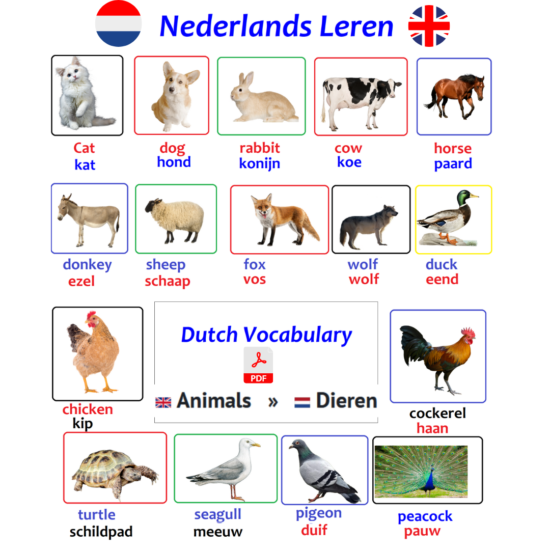Vocabulary exercises to help learn words for different animals.
Learning vocabulary is a big part of learning a language. The more Dutch words you learn, the better you can communicate your needs, ideas, thoughts and feelings to other people in Dutch.
Vocabulary is essential for understanding too. In fact, learning new words is one of the biggest things you can do to improve your reading and listening.
Before We Start .let’s Test your Dutch Vocabulary from here


animals
de dieren

elephant
de olifant

kangaroo
de kangoeroe

rhino
de neushoorn
gorilla
de gorilla

bear
de beer

camel
de kameel

ostrich
de struisvogel

lion
de leeuw

monkey
de aap

flamingo
de flamingo

parrot
de papegaai

polar bear
de ijsbeer

penguin
de pinguïn

shark
de haai

peacock
de pauw

snake
de slang

crocodile
de krokodil

zookeeper
de dierenverzorger

seal
de zeehond

jaguar
de jaguar

pony
de pony

leopard
de/het luipaard

hippo
het nijlpaard

giraffe
de giraffe

eagle
de adelaar

boar
het wild zwijn

fish
de vis

turtle
de schildpad

fox
de vos

gazelle
de gazelle

frog
de kikker

moose
de eland

hare
de haas

owl
de uil

swan
de zwaan

animal feed
het dierenvoer

bird
de vogel

deer
het hert

goat
de geit

donkey
de ezel

horse
het paard

cat
de kat

rabbit
het konijn

duck
de eend

wolf
de wolf

squirrel
de eekhoorn

hedgehog
de egel

chicken
de kip

cock
de haan

pigeon
de duif

jellyfish
de kwal

mouse
de muis

cow
de koe

goose
de gans
bull
de stier

eagle
de adelaar

pig
het varken
 rat
rat
de rat
Download Our Learn Dutch App –here
what can you do to build your Dutch vocabulary quickly and effectively? Here are five tips for better vocabulary learning.
-
1.Write down new words
It’s a really good idea to write down useful new vocabulary. The act of writing the words helps you remember them better. Plus, lots of people learn better when they see things written on paper, rather than just hearing them.
You can add a translation in your language, a definition in Dutch, a note on pronunciation or even a drawing! The more different links you make between the word and its meaning, the better.
- 2. Revise new vocabulary regularly So, you’ve got a Dutch notebook full of useful vocabulary to remember. But did you know that if you don’t look again at the new words and phrases you’ve studied, you only remember on average 20–25 per cent of it? That’s a shocking waste of time and effort!The good news is that if you look at your notes again after an hour, again the next day and once more after a few days, you can make sure that 100 per cent of what you learn goes into your long-term memory.So make five minutes each day to revise your Dutch vocabulary. The more you look backwards, the faster you go forwards!
-
3. Read in Dutch
They say the best way to learn a language is by immersion – spending time completely surrounded by that language.
Well, reading is like immersion through your imagination!
Reading is amazing for your Dutch in general. But it’s particularly good for learning new vocabulary. That’s because understanding a new word as part of a story makes it much more memorable than trying to learn a list of words out of context.
-
4. Learn from context
Speaking of context, let’s talk more about that. Literally, ‘context’ means the text that comes before and after a particular word. It also refers to the situation in which a word is used.
Context is your friend when you’re learning new vocabulary! It helps you guess the meaning of words you don’t know, it shows you how a word is used in a sentence, and it helps you remember the word for longer.
This means learning vocabulary by reading and listening is more effective than trying to study word lists. It also means that it’s better to make a note of how a word is used in a sentence, rather than just the word on its own. For example, instead of ‘to make up = to invent’, try learning, ‘He’d totally made the story up!’. You’ve got useful information there – about the meaning, the types of things people ‘make up’ and the word order.
-
5. Use it or lose it!
Following the ‘use it or lose it’ principle, using words is the best way to make sure you don’t forget them. So try using new vocabulary as soon as you can when you’re speaking or writing in Dutch.
Have you noticed that you often need to use the same words and phrases when you’re communicating in Dutch ? It’s really worth the effort to practice the most common and the most useful words for you.
Researchers have found that you need to see or hear a word on average ten times to remember it. But when you’re actively making an effort with a word – for example, you ask the person you’re talking to how to say something – you learn it much faster.
So, get out there! Try to get as much exposure to Dutch as you can. And take every opportunity to communicate in Dutch with other people.
Caroline






